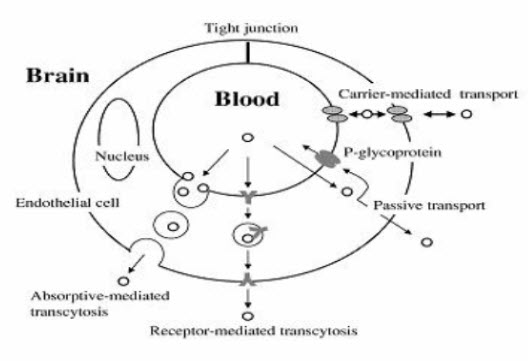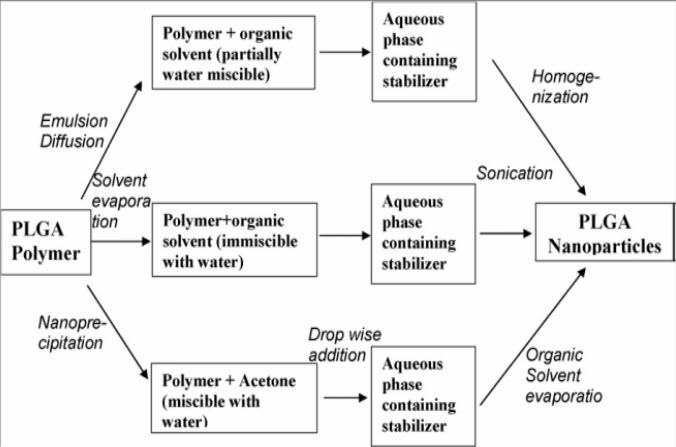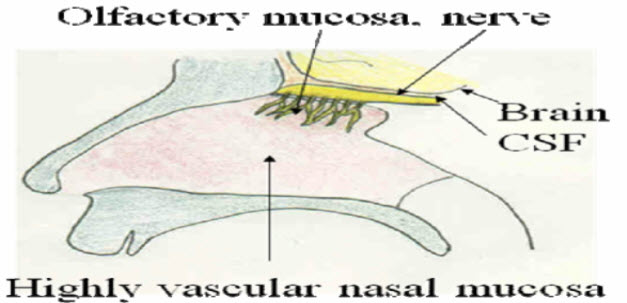ABOUT AUTHORS:
Rakhi Choudhary*, Lakshmi Goswami , Preeti Kothiyal
Shri Guru Ram Rai Institute of Technology & Science P.O. Box - 80, Patel Nagar,
Dehradun 248001, Uttarakhand , India
rakhichaudhary211@gmail.com
ABSTRACT
Major depression is a mood disorder characterized by a sense of inadequacy, despondency, decreased activity, pessimism and sadness where these symptoms severely disrupt and adversely affect the person’s life, sometimes to such an extent that suicide is attempted or results. Various Strategies are used for the treatment of depression by giving drug by various routes. Nasal drug delivery is the best route for treatment of CNS disorder as it is the direct route for the delivery of drug.
REFERENCE ID: PHARMATUTOR-ART-2011
INTRODUCTION:
As estimated by WHO, depression shall become the second largest illness in terms of morbidity by another decade in the world, already one out of every five women, and twelve men have depression. Not just adults, but two percent of school children, and five percent of teenagers also suffer from depression, and these mostly go unidentified. Depression has been the commonest reason why people come to a psychiatrist, although the common man's perception is that all psychological problems are depression[1,2].
TYPES OF DEPRESSION
Depressive illness comes in different forms, just as many other illnesses:
* Major depression is manifested by a combination of symptoms that interfere with the ability to work, sleep, eat and enjoy once pleasurable activities. These disabling episodes of depression can occur once, twice or several times in a lifetime.
* Dysthymia, a less severe type of depression, involves long-term, chronic symptoms that do not disable, but keep you from functioning at “full steam” or from feeling good. Sometimes people with dysthymia also experience major depressive episodes.
* Manic-depressiveor bipolar is not nearly as prevalent as other forms of depressive illnesses. It involves cycles of depression and elation or mania. Sometimes the mood switches are dramatic and rapid, but most often they are gradual. When in the depressed cycle, one can have any or all other the symptoms of a depressive illness. When in the manic cycle, any or all symptoms listed under mania may be experienced. Mania often affects thinking, judgment, and social behaviour in ways that may cause serious problems and embarrassment[3,4].
Depression is an illness with a combination of associated symptoms of which the dominant one is a depressed state of mind accompanied by feelings of sadness and/or anxiety and/or irritability. It is a lengthy illness (i.e. one lasting at least two weeks).
Depression affects the way we function in various ways:
* Biological functions: a disturbed sleep pattern; increased or reduced appetite; reduced libido and energy;
* Motivational functions: a reduced interest in others, in leisure activities, in daily life, in doing activities or reduced pleasure in doing them, a feeling of uselessness and incompetence and in the worst cases suicidal feelings;
* Cognitive functions: loss of self-esteem, inability to take decisions, pessimism and despair, reduced powers of concentration or attention; generally negative psychological attitudes;
* Behavioural functions: slower cerebral or motor functions, or, conversely, an agitated state; reduced frequency of active and productive behaviour, increased frequency of passive and unproductive behaviour.
Sleep alterations and depression:
Sleep alterations is associated with affective disorders. The most common complaint of sleep disturbance in patients with major depression is insomnia. Difficulty falling asleep, frequent nocturnal awakenings, early morning awakening, non sleep, decreased total sleep, and disturbing dreams with more negative emotional content are often reported[5].
Objective sleep disturbances as assessed by polysomnographic recordings, confirm subjective experience in the majority of depressed patients. However, manifestation of most sleep abnormalities only occurs when depressive symptoms are present.
Usually, sleep alterations in depression are grouped into three general categories:-
* Sleep continuity disturbances- Prolonged sleep latency, frequent arousals during sleep and early awakening in the morning. The sleep is more fragmentized which results in decreased sleep efficiency and reduced amount of sleep.
* Slow wave sleep(SWS changes)- SWS processes depression as indicated by a reduction of the SWS.
* REM sleep changes- A reduced REM sleep latency (period of time from sleep onset to the first REM sleep period, prolonged duration of the first REM sleep episode, increased percentage of REM sleep and more frequent eye movements (increased REM sleep density during REM sleep are often reported in depression[6,7].
Depression usually leads to
- Difficulty getting to sleep
- Poor quality sleep
- Fewer Hours of sleep
- More awakenings during the night
- In severe cases, waking very early in the morning and being unable to get back to sleep
- Daytime tiredness
Advances in understanding of the cell biology of the BBB have opened new avenues and possibilities for improved drug delivery to the Central Nervous System (CNS). The blood brain barrier transport mechanism is shown in fig. 1
Various strategies are available for the treatment of depression[8].
Strategies for brain delivery of drug:
* Invasive Strategies
BBB disruption
Intracerebral implants
* Physiological Strategies
Pseudo nutrients
Ligand binding proteins
Chimeric peptides
* Pharmacological Strategies
Prodrug based brain targeting
Nanoparticles
Redox chemical delivery system
Liposomes.
Nanoconjugates
Vector mediated delivery

One of the most commonly used pharmacological strategies for the treatment of various neurological disorders like depression is nanoparticles.
Nanoparticles
Nanoparticles are sub nanosized colloidal structures composed of synthetic or semi synthetic polymers.Nanospheres are solid core spherical particulates which are nanometric in size. They contain drug embedded within the matrix or adsorbed on to the surface .Nanocapsules are vesicular system in which drug is essentially encapsulated with in the central volume surrounded by an embryonic polymeric sheath. In nanocrystals drug is mainly encapsulated in the solution system[9].
Nanoparticles generally vary in size from 10 to 1000 nm. The drug is dissolved, entrapped, encapsulated or attached to a NP matrix and depending upon the method of preparation, nanoparticles, nanospheres or nanocapsules can be obtained[10].
Preparation of nanoparticles
Conventionally, NPs have been prepared mainly by two methods: (i) dispersion of the preformed polymers; and (ii) polymerization of monomers.
Dispersion of preformed polymers:
Solvent evaporation method
The polymer is dissolved in an organic solvent like dichloromethane, chloroform or ethyl acetate. The drug is dissolved or dispersed into the preformed polymer solution, and this mixture is then emulsified into an aqueous solution to make an oil (O) in water (W) i.e., O/W emulsion by using a surfactant / emulsifying agent After the formation of a stable emulsion, the organic solvent is evaporated either by increasing the temperature /under pressure or by continuous stirring[11].

Fig.2: Different method for the synthesis of PLGA nanoparticles: Mostly, PLGA nanoparticles were synthesized by emulsion diffusion, solvent evaporation and nanoprecipitation methods.
Spontaneous emulsification /solvent diffusion method
In a modified version of the solvent evaporation method the water-soluble solvent like ace tone or
methanol along with the water insoluble organic solvent like dichloromethane or chloroform were used as an oil phase. Due to the spontaneous diffusion of water-soluble solvent (acetone or methanol), an interfacial turbulence is created between two phases leading to the formation of smaller particles[12].
Production of NPs using supercritical fluid technology[13]
If solvent impurities remain in the drug-loaded NPs, then these become toxic and may degrade the pharmaceuticals within the polymer matrix. Supercritical fluids have now became the attractive alternatives because these are environmentally friendly solvents and the method can be profitably used to process particles in high purity and without any trace amount of the organic solvent.
Nasal drug delivery is the best route for the delivery of the drug in the CNS as it is the direct pathway to deliver drug to brain.
NOSE TO BRAIN DELIVERY
The olfactory region is a small patch of tissue containing the smell receptor and is located at the very top of the nasal cavity near the inner end of the upper throat. The patch has a yellowish tinge, in contrast to its surrounding pink tissue, and consists of several million tiny endings of the olfactory nerve whose bundle passes through the cribiform plate and enters the farthest forward extension of the brain as shown in figure 3.

Fig. 3: Olfactory mucosa, a pathway for nose to brain delivery
The olfactory epithelium is known to be a portal of entry for substance into the central nervous system and peripheral circulation. The transport of the drug across the nasal membrane and into the bloodstream may involve either passive diffusion of drug through the pores in the nasal mucosa or some from non passive transport.
NASAL DOSAGE FORMS[14]
v Gels:
Nasal gels are high-viscosity thickened solutions or suspensions, prepared from both natural and synthetic polymers. Owing to their high viscosity, they can remain in the nasal cavity for a long time and hence enhance the bioavailability of the drug.
v Nasal drops:
Nasal drops are the most convenient systems developed for nasal delivery.
v Nasal sprays:
Nasal sprays are used for the nasal deliveryof a drug or drugs, either locally to generallyalleviate cold or allergy symptoms such asnasal congestion or systemically.
v Nasal Inserts:
Nasal inserts are novel, bio adhesive, solid dosage forms for prolonged systemic drug delivery via the nasal route. The principle of the dosage form is to imbibe nasal fluid from the mucosa after administration and to form a gel in the nasal cavity to avoid foreign body sensation.
v Nasal powders:
Dry-powder nasal formulations are the most widely used in situ gelling formulations and have been historically used mostly for locally acting drugs, as in rhinitis treatment.
CONCLUSION:
Drug delivery to the brain is a challenging task in the treatment of various diseases related to Central Nervous System (CNS) like depression. Nasal drug delivery is a non invasive method of by passing the blood brain barrier (BBB) in order to deliver therapeutic agents to the brain. This method is generally useful for those drugs that do not cross the BBB to be delivered to the central nervous system in a few minutes along with both the olfactory and trigeminal neuronal pathway. Nanoparticles are formulated and delivered by nasal route in the form of gels, powders, spray, inserts etc.Nanoparticles may offer an improvement to nose-to-brain drug delivery since they are able to protect the encapsulated drug from biological and/or chemical degradation, and extracellular transport by efflux proteins .This would increase CNS availability of the drug.
REFERENCE
1.R.C Kessler, K.A Gonagle, S Zhao (2003). Lifetime and 12-month prevalence of DSM-IIIR psychiatric disorders in the United States, Results from the National Comorbidity Survey Arch Gen Psychiatry, 51:8-19.
2. L. Robins, D. Regier (2004). Psychiatric Disorders in America, New York: Free Press
3.W Katon (2006). The epidemiology of depression in medical care, Int J Psychiatry Med, 17:93-112.
4. L.L Judd (2008). The clinical course of uni polar major depressive disorders, Arch Gen Psychiatry, 54, 989-991
5.HP Rang, MM Dale, JM Ritter (1999). Drugs used in affective disorders in Pharmacology.
6.Michael Berk (2009). Sleep and depression ? theory and practice, In: Documents for small business and professions.
7.DJ Kupfer (1995). Sleep research in depressive illness: Clinical implications: a tasting menu, Biol. Psychiatry, 38 :391–403.
8.Arun Rasheed (2010) CNS targeted drug delivery: current perspectives” JITPS, 1(1):9-18.
9.J. Kreuter (1994). Nanoparticles. In: Colloidal Drug Delivery Systems, J. New York: Marcel Dekker, 261?276.
10.Tejraj Aminabhavi (2001). Biodegradable polymeric nanoparticles as drug delivery devices, Journal of Controlled Release 70:1–20.
11.P.D. Scholes, A. Coombes, L. Illum, S.S. Davis, M. Vert, M.C. Davies (1993). The preparation of sub-500 nm poly(lactide co-glycolide) microspheres for site-specific drug delivery, J. Control. Rel, 25: 145–153.
12.T. Niwa, H. Takeuchi, T. Hino, N. Kunou, Y. Kawashima (1993). Preparations of biodegradable nanospheres of water-soluble and insoluble drugs with D,L-lactide / glycolide copolymer by a novel spontaneous emulsification solvent diffusion method and the drug release behavior, J. Control. Rel, 25:89–98.
13.K. Mishima, K. Matsuyama, D. Tanabe, S. Yamauchi (2000). Microencapsulation of proteins by rapid expansion of super polycritical solution with a nonsolvent, AIChE J, 46:857–865.
14.A.K Bandyopadhyay (2010).Nasal Drug Delivery: An Overview, Int J Pharm Sci Tech,4.
NOW YOU CAN ALSO PUBLISH YOUR ARTICLE ONLINE.
SUBMIT YOUR ARTICLE/PROJECT AT articles@pharmatutor.org
Subscribe to Pharmatutor Alerts by Email
FIND OUT MORE ARTICLES AT OUR DATABASE









